Ethiopian cuisine offers a unique and rich culinary experience that combines bold flavors and traditional cooking methods.
It features a variety of spices, legumes, and meats that create hearty, flavorful dishes. Exploring Ethiopian food can be an exciting experience through a mix of savory and spicy flavors.
You will quickly discover a world of delicious dishes that reflect the country’s diverse culture and history.
Trying these 10 best Ethiopian dishes will give you a genuine taste of what makes this cuisine special.
10) Firfir
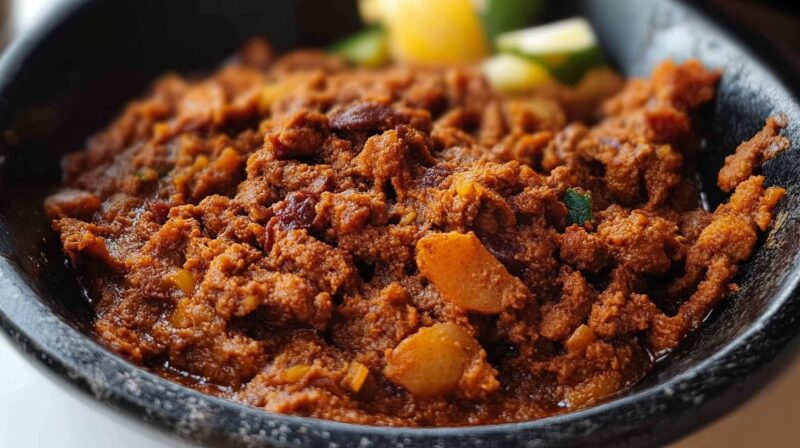
Firfir is a popular Ethiopian dish made with shredded injera. Injera is a sourdough flatbread that is a staple in Ethiopian cuisine.
The injera is mixed with clarified butter called kibe and seasoned with berbere. Berbere is a blend of spices that adds a rich, spicy flavor to the dish.
Firfir often includes onions, tomatoes, and sometimes chili. These ingredients are sautéed and mixed in with the injera, creating a flavorful and satisfying meal.
You can enjoy firfir for breakfast, lunch, or dinner. It is hearty and often served with yogurt or other side dishes.
Firfir is a great way to experience the unique flavors of Ethiopian cuisine in a simple yet delicious manner.
9) Atayef

Atayef, also known as Qatayef, is a delightful Middle Eastern pastry. These pancake-like treats are often filled with sweet cheese or nuts. They are a staple during Ramadan but are enjoyed year-round.
To make Atayef, you start with a batter similar to a pancake mix. Cook one side on a skillet until bubbles form. The uncooked side remains soft, ready to hold the filling.
You can fill Atayef with cream cheese or a nut mixture. Once filled, fold them into a half-moon shape and pinch the edges to seal.
You have options for cooking Atayef. Deep fry them in hot oil until crispy and golden. You can use an air fryer for a lighter version. After frying, dip them in simple syrup for a sweet finish.
Atayef offers a range of flavors and textures. The crispy outside contrasts beautifully with the creamy or nutty filling inside. Whether you stick to tradition or explore new fillings, Atayef is sure to be a crowd-pleaser.
8) Chechebsa
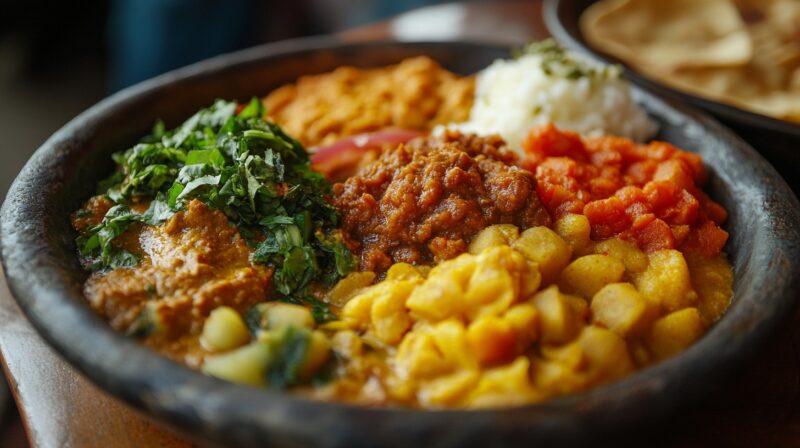
Chechebsa, also known as Kita Firfir, is a popular Ethiopian breakfast dish. It’s made from pieces of flatbread mixed with spices.
The flatbread is typically pan-fried until crispy.
To prepare Chechebsa, you start by rolling out the dough until it gets very thin. Add some oil to a frying pan and heat it up.
Place the dough flat on the hot pan and let it cook for a couple of minutes on each side.
Once the flatbread is ready, you tear it into small pieces. These pieces are then mixed with melted kibe (Ethiopian clarified butter) or oil.
Add spices like berbere or mitmita, which give the dish a spicy kick. Some people also add yogurt or honey for extra flavor.
7) Gored Gored
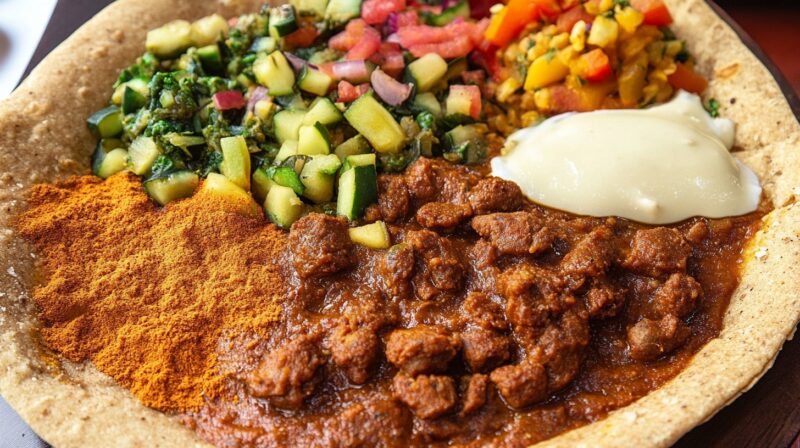
Gored Gored is an Ethiopian dish made from raw beef. The beef is cut into small cubes and mixed with spices. It’s a favorite among those who enjoy fresh, raw meat dishes.
The meat is typically seasoned with berbere, a spice blend that gives it a fiery kick. You might also find it mixed with awaze, a spicy sauce made from berbere, garlic, and olive oil.
Preparation begins by cutting fresh beef into small pieces. The meat is then tossed in a mixture of spices, ensuring each piece is well-coated. It is often lightly salted to taste.
Traditionally, Gored Gored is served with injera, a spongy flatbread made from teff flour. Injera helps balance the heat of the spices and enhances the overall flavor experience.
This dish is quick to prepare since it requires no cooking. Just make sure the beef is of high quality and very fresh.
Enjoy Gored Gored with sautéed vegetables or a simple salad on the side. It’s a unique and exciting way to experience Ethiopian cuisine’s bold flavors.
6) Misir Wot
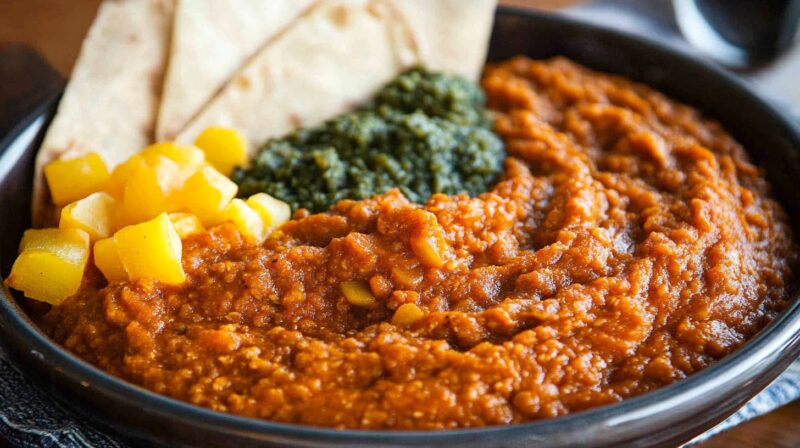
Misir Wot is a flavorful Ethiopian dish made from red lentils. These lentils are cooked with a rich mix of spices, making the dish both hearty and spicy. It’s a staple in Ethiopian cuisine and a favorite among vegetarians.
The key ingredients in Misir Wot include red lentils, tomatoes, and niter kibbeh, a spiced clarified butter. Berbere, a mix of spices including chili powder, garlic, ginger, and basil, gives the dish its characteristic heat.
Cooking Misir Wot is straightforward. The lentils are simmered in water with the spices until tender. The result is a thick, stew-like consistency that pairs perfectly with injera, a traditional Ethiopian flatbread.
You can easily make Misir Wot at home. It’s nutritious, packed with protein, and satisfying. The flavors are deep and rich, making every bite enjoyable. It’s a great way to enjoy an authentic taste of Ethiopia in your own kitchen.
Trying Misir Wot in an Ethiopian restaurant can be a memorable experience. The communal eating style, using injera to scoop up the lentils, adds to the dish’s charm. Whether at home or dining out, Misir Wot offers a delicious insight into Ethiopian culinary traditions.
5) Shiro Wat
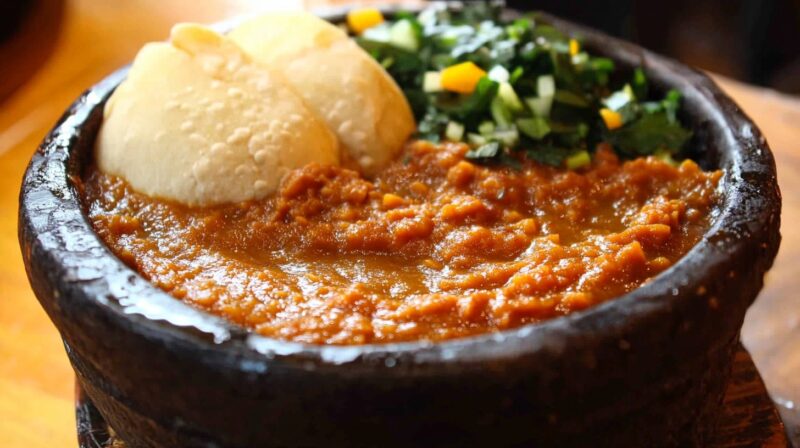
Shiro Wat is a traditional Ethiopian chickpea stew that is both delicious and comforting. Made from finely ground chickpea flour, this dish is a staple in many Ethiopian households.
To start, you need finely ground chickpea flour, also known as shiro powder. You will also need onions, garlic, and tomatoes for the base. The vegetables are sautéed until fragrant.
Gradually, the shiro powder is added to the pot. It’s crucial to stir continuously to avoid lumps. Slowly pour in boiled water, stirring all the while. This helps create a smooth, thick consistency similar to gravy.
Continue cooking on low heat until the mixture thickens. Shiro Wat is often enjoyed with injera, a type of Ethiopian flatbread, making it perfect for scooping up the rich stew. It’s a hearty, savory dish that’s both vegan and gluten-free.
4) Tibs
Tibs is a popular Ethiopian dish enjoyed by many. It consists of small pieces of meat like beef, lamb, or goat. You can also use fish or chicken. The meat is pan-fried and cooked with onions, garlic, and sometimes tomatoes and peppers.
Tibs is often prepared with a blend of spices. It is typically cooked in butter, which enhances the flavor. Some variations also include berbere, a traditional Ethiopian spice mix. This gives the dish a spicy kick.
You might find Tibs served in a clay pot, which helps keep it warm. It is usually enjoyed with injera, a spongy flatbread that is a staple in Ethiopian cuisine. The bread is used to scoop up the Tibs and soak up its rich sauce.
There are different varieties of Tibs, including Shekla Tibs. This version is served on a hot plate or in a clay pot. Another type is Dereq Tibs, which uses dried meat. Each version offers a unique taste experience.
Tibs can be found in many Ethiopian restaurants. It is a versatile dish that can be adjusted to fit your spice preference. Whether you like it mild or spicy, Tibs is sure to be a delightful addition to your meal.
3) Injera
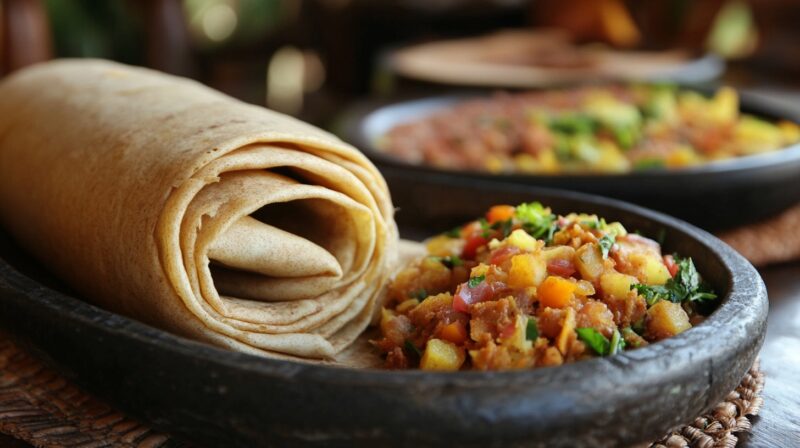
Injera is a staple in Ethiopian cuisine, and you can’t truly experience Ethiopian food without trying it. It’s a large, round, and flatbread made mainly from teff flour. Teff is a grain native to Ethiopia, known for its high nutritional value. It contains:
- 3% fat,
- 11% protein,
- 80% complex carbohydrate
The unique taste of injera comes from its fermentation process, which lasts several days. That gives injera its tangy flavor, similar to sourdough bread. The texture is soft and spongy, making it perfect for scooping up stews and other dishes.
When you first see injera, you’ll notice its surface is covered with tiny holes. These holes form naturally during cooking and give the bread a unique appearance.
Eating injera is not just about the taste but also the experience. It’s traditionally served on a large platter with various side dishes placed on top. You use the injera like an edible plate, tearing off pieces to pick up the food.
Making injera at home can be a bit tricky. You might use teff flour and let the batter ferment. Pour it onto a hot skillet, let the bubbles form, and steam cook it for a few more minutes.
Injera is also versatile. It can be enjoyed with meat, vegetables, and even vegan dishes.
2) Kitfo
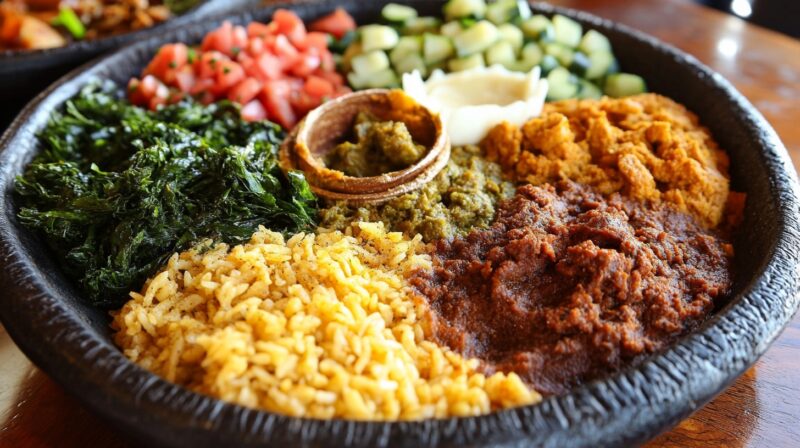
Kitfo is a celebrated Ethiopian dish made from raw minced beef. It’s seasoned with a blend of spices, including mitmita, which is a chili powder mix, and niter kibbeh, a seasoned clarified butter.
This dish is often enjoyed during special occasions and holidays. It’s traditionally accompanied by injera, a spongy flatbread, and various side dishes like ayib, a fresh cheese.
If you prefer your meat cooked, you can ask for your kitfo to be cooked lightly, known as kitfo leb leb. This option offers you a slightly different taste while maintaining the rich flavors.
When you try kitfo, you’ll experience the unique blend of spices and textures. This makes it a memorable and tasty dish that showcases the depth of Ethiopian cuisine.
1) Doro Wot
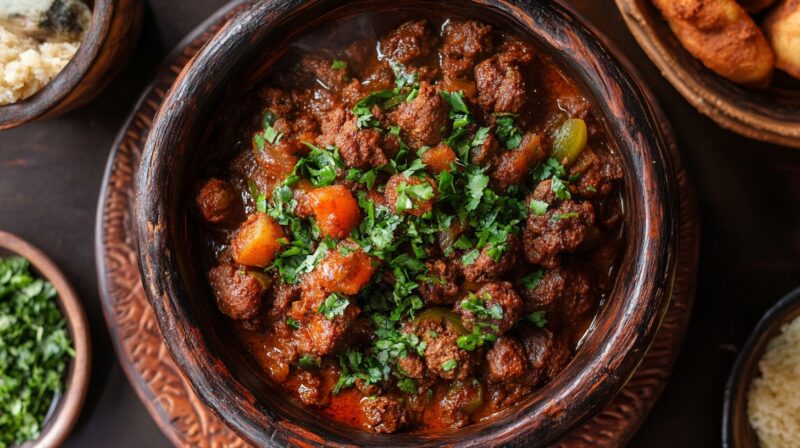
Doro Wot is one of Ethiopia’s most famous dishes. It’s a spicy chicken stew made with berbere spice and niter kibbeh, a seasoned clarified butter.
You start by cooking onions until they caramelize. Once they are brown, you add garlic, ginger, berbere, and niter kibbeh to form a rich, flavorful base.
Next, you add chicken pieces to the pot. It’s common to use chicken drumsticks or thighs. The chicken simmers in the sauce, absorbing all the spices, for about 45 minutes to an hour.
To finish, you add hard-boiled eggs to the stew. The eggs soak up the spicy sauce, making them a delicious addition.
Doro Wot is often served with injera, a traditional Ethiopian flatbread. The bread helps to balance the heat of the stew and complements its deep flavors.
Summary
Ethiopian cuisine offers a rich variety of flavors and textures. From the spice-infused meats to the hearty vegetarian dishes, there’s something for everyone.
You’ll find that many dishes are healthy, as they often use fresh ingredients and traditional cooking methods.
Next time you dine out or cook at home, consider these Ethiopian dishes. They’re more than just food; they’re a taste of Ethiopian culture and history.
Trying these dishes will broaden your culinary experience and introduce you to new flavors and ingredients. Enjoy exploring Ethiopian cuisine!
If you ever go souvenir hunting, remember that the food is the best one you can find!

